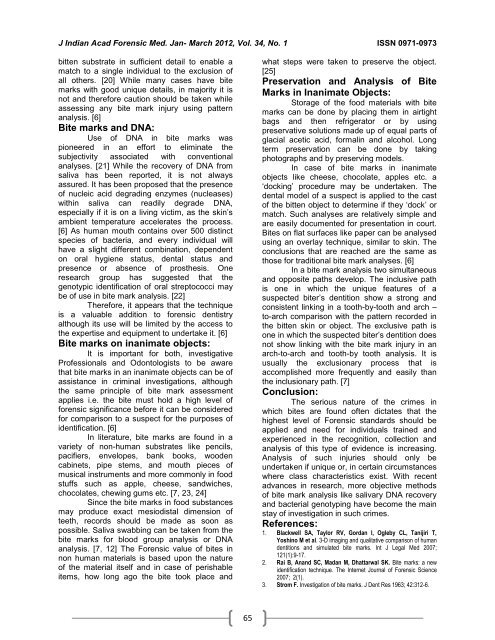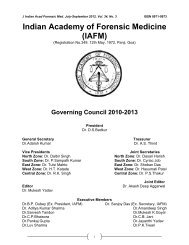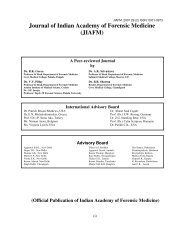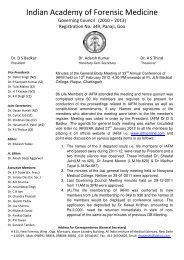Indian Academy of Forensic Medicine (IAFM) - Official website of IAFM
Indian Academy of Forensic Medicine (IAFM) - Official website of IAFM
Indian Academy of Forensic Medicine (IAFM) - Official website of IAFM
Create successful ePaper yourself
Turn your PDF publications into a flip-book with our unique Google optimized e-Paper software.
J <strong>Indian</strong> Acad <strong>Forensic</strong> Med. Jan- March 2012, Vol. 34, No. 1 ISSN 0971-0973<br />
bitten substrate in sufficient detail to enable a<br />
match to a single individual to the exclusion <strong>of</strong><br />
all others. [20] While many cases have bite<br />
marks with good unique details, in majority it is<br />
not and therefore caution should be taken while<br />
assessing any bite mark injury using pattern<br />
analysis. [6]<br />
Bite marks and DNA:<br />
Use <strong>of</strong> DNA in bite marks was<br />
pioneered in an effort to eliminate the<br />
subjectivity associated with conventional<br />
analyses. [21] While the recovery <strong>of</strong> DNA from<br />
saliva has been reported, it is not always<br />
assured. It has been proposed that the presence<br />
<strong>of</strong> nucleic acid degrading enzymes (nucleases)<br />
within saliva can readily degrade DNA,<br />
especially if it is on a living victim, as the skin’s<br />
ambient temperature accelerates the process.<br />
[6] As human mouth contains over 500 distinct<br />
species <strong>of</strong> bacteria, and every individual will<br />
have a slight different combination, dependent<br />
on oral hygiene status, dental status and<br />
presence or absence <strong>of</strong> prosthesis. One<br />
research group has suggested that the<br />
genotypic identification <strong>of</strong> oral streptococci may<br />
be <strong>of</strong> use in bite mark analysis. [22]<br />
Therefore, it appears that the technique<br />
is a valuable addition to forensic dentistry<br />
although its use will be limited by the access to<br />
the expertise and equipment to undertake it. [6]<br />
Bite marks on inanimate objects:<br />
It is important for both, investigative<br />
Pr<strong>of</strong>essionals and Odontologists to be aware<br />
that bite marks in an inanimate objects can be <strong>of</strong><br />
assistance in criminal investigations, although<br />
the same principle <strong>of</strong> bite mark assessment<br />
applies i.e. the bite must hold a high level <strong>of</strong><br />
forensic significance before it can be considered<br />
for comparison to a suspect for the purposes <strong>of</strong><br />
identification. [6]<br />
In literature, bite marks are found in a<br />
variety <strong>of</strong> non-human substrates like pencils,<br />
pacifiers, envelopes, bank books, wooden<br />
cabinets, pipe stems, and mouth pieces <strong>of</strong><br />
musical instruments and more commonly in food<br />
stuffs such as apple, cheese, sandwiches,<br />
chocolates, chewing gums etc. [7, 23, 24]<br />
Since the bite marks in food substances<br />
may produce exact mesiodistal dimension <strong>of</strong><br />
teeth, records should be made as soon as<br />
possible. Saliva swabbing can be taken from the<br />
bite marks for blood group analysis or DNA<br />
analysis. [7, 12] The <strong>Forensic</strong> value <strong>of</strong> bites in<br />
non human materials is based upon the nature<br />
<strong>of</strong> the material itself and in case <strong>of</strong> perishable<br />
items, how long ago the bite took place and<br />
65<br />
what steps were taken to preserve the object.<br />
[25]<br />
Preservation and Analysis <strong>of</strong> Bite<br />
Marks in Inanimate Objects:<br />
Storage <strong>of</strong> the food materials with bite<br />
marks can be done by placing them in airtight<br />
bags and then refrigerator or by using<br />
preservative solutions made up <strong>of</strong> equal parts <strong>of</strong><br />
glacial acetic acid, formalin and alcohol. Long<br />
term preservation can be done by taking<br />
photographs and by preserving models.<br />
In case <strong>of</strong> bite marks in inanimate<br />
objects like cheese, chocolate, apples etc. a<br />
‘docking’ procedure may be undertaken. The<br />
dental model <strong>of</strong> a suspect is applied to the cast<br />
<strong>of</strong> the bitten object to determine if they ‘dock’ or<br />
match. Such analyses are relatively simple and<br />
are easily documented for presentation in court.<br />
Bites on flat surfaces like paper can be analysed<br />
using an overlay technique, similar to skin. The<br />
conclusions that are reached are the same as<br />
those for traditional bite mark analyses. [6]<br />
In a bite mark analysis two simultaneous<br />
and opposite paths develop. The inclusive path<br />
is one in which the unique features <strong>of</strong> a<br />
suspected biter’s dentition show a strong and<br />
consistent linking in a tooth-by-tooth and arch –<br />
to-arch comparison with the pattern recorded in<br />
the bitten skin or object. The exclusive path is<br />
one in which the suspected biter’s dentition does<br />
not show linking with the bite mark injury in an<br />
arch-to-arch and tooth-by tooth analysis. It is<br />
usually the exclusionary process that is<br />
accomplished more frequently and easily than<br />
the inclusionary path. [7]<br />
Conclusion:<br />
The serious nature <strong>of</strong> the crimes in<br />
which bites are found <strong>of</strong>ten dictates that the<br />
highest level <strong>of</strong> <strong>Forensic</strong> standards should be<br />
applied and need for individuals trained and<br />
experienced in the recognition, collection and<br />
analysis <strong>of</strong> this type <strong>of</strong> evidence is increasing.<br />
Analysis <strong>of</strong> such injuries should only be<br />
undertaken if unique or, in certain circumstances<br />
where class characteristics exist. With recent<br />
advances in research, more objective methods<br />
<strong>of</strong> bite mark analysis like salivary DNA recovery<br />
and bacterial genotyping have become the main<br />
stay <strong>of</strong> investigation in such crimes.<br />
References:<br />
1. Blackwell SA, Taylor RV, Gordan I, Ogleby CL, Tanijiri T,<br />
Yoshino M et al. 3-D imaging and qualitative comparison <strong>of</strong> human<br />
dentitions and simulated bite marks. Int J Legal Med 2007;<br />
121(1):9-17.<br />
2. Rai B, Anand SC, Madan M, Dhattarwal SK. Bite marks: a new<br />
identification technique. The Internet Journal <strong>of</strong> <strong>Forensic</strong> Science<br />
2007; 2(1).<br />
3. Strom F. Investigation <strong>of</strong> bite marks. J Dent Res 1963; 42:312-6.









